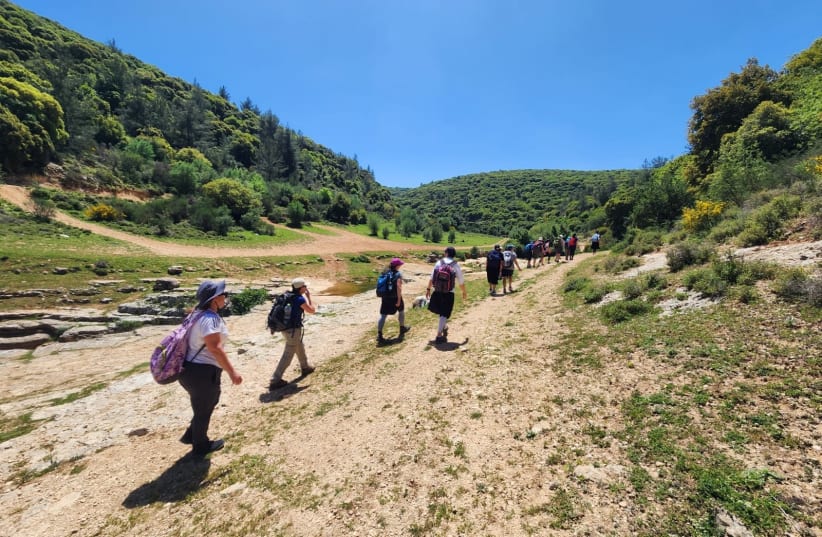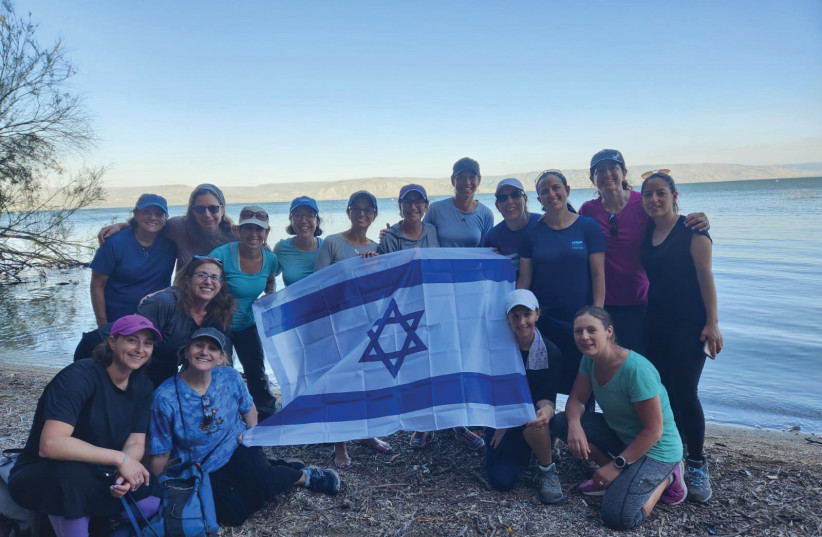On the fourth day, the guide offered the hikers a shortcut. They could skip the steep, rocky descent to the Amud stream marked “for experienced hikers.” That would, however, mean they would miss out on the beautiful pools and wildflowers, not to mention the view.
The vote was unanimous. No skipping. No shortcuts.
The 16 women, from ages 39 to 63, don’t belong to a hiking group or rambling club. They simply saw a poster in English advertising “Sea to Sea” (Yam L’ Yam), an invitation for women to take part in a traditional Israeli trail walk. For some, signing up was an on-the-spot decision, something out of the blue. For others, like co-organizer Sherrill Kaye, this was a long-time goal buzzing in the back of her mind. Her son had hiked Sea to Sea. Her daughter had hiked Sea to Sea. “I’d lived in this country for 17 years, and I had this nagging feeling that I hadn’t walked enough of it,” said Kaye.
The moment of decision that turned a “one day I want to” into a concrete project was hearing about the recent Sea to Sea hike completed by the men in her Modi’in synagogue, Kehillat Shaarei Yonah Menachem. “There has to be a woman’s hike, ”she thought.
“I’ve lived in Israel for 17 years, but trekking step by step with perseverance and sweat gave me an even deeper connection to this beautiful land of ours.”
Sherrill Kaye
Getting women immigrants to Israel to hike Sea to Sea
First step: a decision. Second step: recruiting a partner. Over lunch, her friend Anat Schlocker – like Kaye, a young-spirited grandmother – agreed to share the organization and to walk. Next, they got serious about the planning – seeking a guide, pricing group transportation, and finding accommodation and food.
Unlike the youngsters who frequent the Sea to Sea trail, these women weren’t going to bivouac or eat from cans of corn around a campfire. Once they figured out what it would cost and had a potential guide, they spread the word in their WhatsApp groups and social media. Schlocker’s daughter designed a poster: “Women’s Hiking in Israel, Yam L’Yam Trek,” with their phone numbers.
Kaye hoped to get 11 women so that the final cost would be affordable (NIS 1,950 per person). Sixteen women signed up – all immigrants, both new and veteran – all from English-speaking countries.
Kaye herself is a very fit fitness instructor for teens and adult women. At 57, she might have been more agile than other women. To qualify, the others simply judged whether they themselves were fit enough and cheerful enough to commit to a four-day, 70-kilometer hike. In case you’re wondering, that’s about 37,000 steps a day, and counting, on your pedometer.
The New York Times recently featured an article about the mental and physical benefits of hiking, but like Kaye, most of the women who signed up spoke more of Zionist motivation than expansion of cardiovascular capacity.
The women came from Modi’in, Beit Shemesh, Yad Binyamin, Efrat, and Netanya. Several of the women would stride with a sibling. A few knew each other ahead of time, but the rest would get to know their fellow hikers as they scrambled over cliffs and dales.
At 5 a.m. on April 17, they assembled outside Kaye’s home in Modi’in. Carry-on-sized luggage would be delivered to their lodgings. Each woman brought her backpack with water, sandwiches and nosh. Calls of nature would have to be, well, in nature. Their chartered bus let them off near Achziv Beach.
WITH THEIR backs to the Mediterranean Sea, and aiming for the Sea of Galilee, they first walked toward the Nahal Kziv Nature Reserve. “Most of day one was sloshing through the stream to Ein Tamir, slow going but exhilarating,” says Kaye. This provided a conversational pace for women among their newfound friends.
By 5 p.m. the women had walked far enough, and their bus driver picked them up. They were pleased to find a swimming pool, hot showers, and their suitcases distributed among the bungalows of Tzuriel, with its view of Mount Meron. A caterer dropped off dinner. 32 women’s hands quickly arranged the table.
That evening coincided with the beginning of Holocaust Remembrance Day. Hiker Batyah Cohen, a new immigrant from Skokie, Illinois, had prepared a talk about her father’s family. Her grandfather survived Mauthausen and was making his way by foot to pre-State Israel. He was already in Italy when he learned that his wife, Cohen’s grandmother, had survived Auschwitz. He turned back to Poland. Life rerouted them to the United States.
Despite only arriving in Israel in 2021, Sea to Sea was a bucket list item for Cohen. In a previous year, she had taken part in another walk, March of the Living. The timing was right. She said, “I knew another kind of ‘hike’ was taking place the very day we were trekking – that commemoration march from Auschwitz to Birkenau – the ‘death march’ the Nazis forced the Jews to do.”
On the second day, the women were off again early, sandwiches packed and water bottles filled, and would hear the mournful Holocaust memorial siren sound from Meron.
Said Cohen, “The sentiment among the group was unanimous – we couldn’t help but compare our life-affirming march across the Promised Land to the marches our relatives had to take. We felt privileged to be freely walking in the Jewish homeland, fulfilling the dream that many others couldn’t.”
Day three was the hardest: scrambling up the steep Meron mountainside. “When we saw the sign advising only experienced hikers to continue, I reassured the other women that we would not take any risks by going down this steep mountain,” said Kaye.
That’s when their Sabra guide offered a shortcut. “We looked at each other. We weren’t buying it. When we got to the top, we took a deep breath, looked at the scenery and said, ‘That really wasn’t so hard.’ Talk about a life lesson.”
Although they usually talked and laughed and sighed and sang their repertoire of Israeli and old-time American songs as they trekked, on the fourth morning they let the chirping of birds, trees rustling and water gurgling fill their souls.
Then, suddenly – they were there – at the Kinneret, the Sea of Galilee. All 16 women made it sea to sea, crossing Israel. They hoisted an Israeli flag and took the requisite photo.
Batyah Cohen said, “For me personally, after four days and 70 km. later, hot, sweaty – with aching feet and shoulders from carrying my bags – I also gained this incredible newfound awe for what my grandfather did walking across Europe, at first to evade Nazis and later to find my grandmother after the war. He didn’t have the luxury of warm showers, packs of food, warm beds, and water like I had, and yet he walked for days, malnourished, in who knows what weather, to survive.”
For organizer Kaye, it was a great sense of satisfaction. “I’ve lived in Israel for 17 years, but trekking step by step with perseverance and sweat gave me an even deeper connection to this beautiful land of ours.”
The writer is the Israel director of public relations and communications at Hadassah, the Women’s Zionist Organization of America. Her latest book is A Daughter of Many Mothers.

